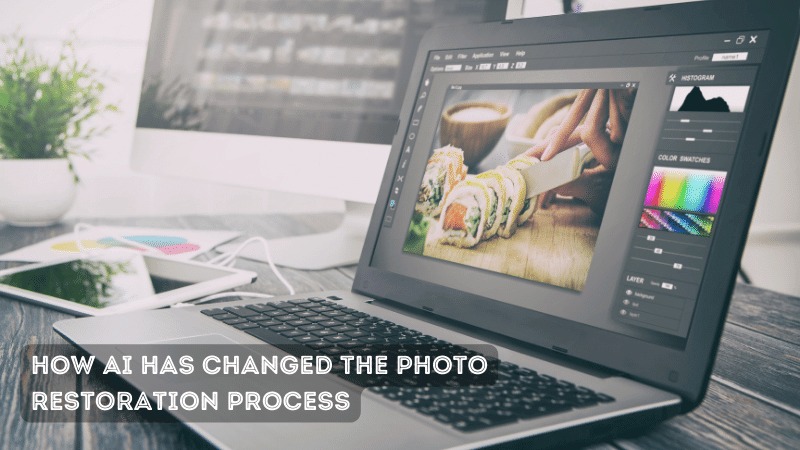How AI has Changed the Photo Restoration Process

It’s truly mind-blowing how AI has revolutionized how we bring old, damaged, or faded photos back to life. Gone are the days when restoring an image meant hours of painstaking manual work. The process has become faster, more efficient, and incredibly accurate thanks to AI-powered tools.
Al tools have been trained on vast databases of images, allowing them to learn patterns and understand the nuances of photo restoration. They can magically repair cracks, tears, and scratches with pinpoint precision. These algorithms are so smart that they analyze the surrounding pixels, figure out the original texture, and seamlessly fill in the damaged areas.
In this guide, you will learn more about how AI has changed the photo restoration process, whether it is beneficial for us or not and what its future is!
Contents
- 1 Traditional Photo Restoration
- 2 An Introduction to AI in Image Restoration
- 3 The Evolution of Photo Restoration with AI
- 4 Applications of AI in Photo Editing and Restoration
- 5 AI Tools and Software for Photo Restoration
- 6 Pros and Cons of AI in Photo Restoration
- 7 Future Outlook of AI in Photo Restoration
- 8 Concluding Remarks
Traditional Photo Restoration
Traditional photo restoration is a process that involves a combination of physical and digital techniques to restore and preserve aged, damaged, or deteriorated photographs. It’s a meticulous craft that demands a keen eye for detail and a wide range of skills.
In the physical realm, this could involve delicately cleaning the photograph and then scanned at a high resolution to create a digital version for further enhancement.
An Introduction to AI in Image Restoration
You won’t believe how much artificial intelligence (AI) has revolutionized the world of photo restoration. It’s like having a super-smart assistant that can accurately analyze, learn, and restore images.
AI algorithms, a special breed of machine learning, can understand the complexities of image restoration. They can analyze large data sets of images, learn from them, and apply that knowledge to restore damaged or faded photos. The best part? They do it all automatically, saving you tons of time and effort.
The Evolution of Photo Restoration with AI

Over the years, the field of photo restoration has undergone a remarkable evolution, thanks to the integration of artificial intelligence (AI) technologies. With AI algorithms and machine learning, the process has transformed from manual labour to automated precision, enabling us to revive and enhance old photos like never before.
The Shift from Manual to Automated Techniques
Transitioning from manual to AI-powered techniques has brought about significant changes in photo restoration. These automated techniques can rapidly analyze an image, identify areas of damage, and apply the most suitable correction. So, it significantly improves the speed and quality of restoration.
Machine Learning Techniques Used in Restoration
The backbone of AI photo restoration lies in Machine Learning (ML) techniques, specifically Convolutional Neural Networks (CNNs) and Generative Adversarial Networks (GANs). These networks process image data remarkably and can learn from past images to restore new ones more effectively.
Applications of AI in Photo Editing and Restoration

The applications of artificial intelligence (AI) in photo editing and restoration are nothing short of remarkable.
1. Help You Choose the Best Photos
AI can now even assist in choosing your best photos. It can identify and recommend the highest-quality images by analyzing factors such as composition, focus, exposure, and facial expressions. Tools like Adobe Lightroom and Google Photos already use this feature to help users streamline their photo selection process.
2. Upscale Low-Resolution Images
AI has made a significant contribution to upscaling low-resolution images. Traditional upscaling often results in a loss of quality. Still, AI algorithms can predict and fill in the details that would typically be lost, resulting in a high-resolution image that retains its quality. AI-based tools like Topaz Labs’ Gigapixel AI offer remarkable results in image upscaling.
3. Sky Replacement
Automatic sky replacement best demonstrates AI’s potential in enhancing landscape photos. AI can identify and mask the sky in an image, allowing for easy replacement with a different sky and creating dramatic and visually striking results. Skylum’s Luminar 4 is a famous example of software using AI for sky replacement.
4. Automatic Masking
Masking, a vital part of photo editing, involves selecting specific areas of an image for independent editing. AI has simplified this process by automatically identifying and masking areas of an image, allowing for more detailed and accurate edits. Adobe Photoshop’s AI-powered Select Subject tool is a vital example of this capability.
5. Adjust Colors and Exposure
AI can also automatically analyze and adjust an image’s colours and exposure, ensuring optimal lighting and vibrant, accurate colours. Tools like Adobe Lightroom use AI to adjust automatically, saving time while ensuring professional-quality results.
AI Tools and Software for Photo Restoration

AI tools for photo restoration are continually evolving, with Adobe Photoshop, Topaz Labs, Image Colorizer and Skylum offering excellent AI-powered tools. These tools leverage AI’s capabilities for tasks ranging from damage repair and colour restoration to exposure correction and artistic enhancements.
Pros and Cons of AI in Photo Restoration
Advantages of AI in Photo Restoration
The benefits of using AI in photo restoration are plentiful.
- AI dramatically increases speed and efficiency
- It provides improved restoration quality
- Reduces the possibility of human error
- It can also handle a large volume of images, making it ideal for large-scale projects.
Disadvantages and Challenges of AI in Photo Restoration
Despite its numerous benefits, AI does have its limitations.
- Its effectiveness relies heavily on the quality and diversity of its training data.
- AI’s inability to understand historical or cultural context can sometimes lead to inappropriate or inaccurate restorations.
Future Outlook of AI in Photo Restoration
The future of AI in photo restoration holds immense potential. Enhanced AI algorithms are being developed for better image understanding, and improved diversity in training data is leading to more accurate repairs. Furthermore, AI’s integration with technologies like Augmented Reality (AR) and Virtual Reality (VR) could revolutionize how we interact with restored photos.
Concluding Remarks
Undoubtedly, AI has brought about a transformative shift in photo restoration. Although challenges persist, AI’s opportunities and advancements far outweigh its limitations. As this technology continues to evolve, its role in preserving our visual history will only become more significant.
Experience the power of AI-driven restoration firsthand with Image Colorizer. Bring your old photos back to life and preserve your precious memories with this exceptional tool.
Meta Description:
Curious about how AI has wholly transformed the photo restoration process? Discover the power of AI in bringing your cherished memories back to life.






